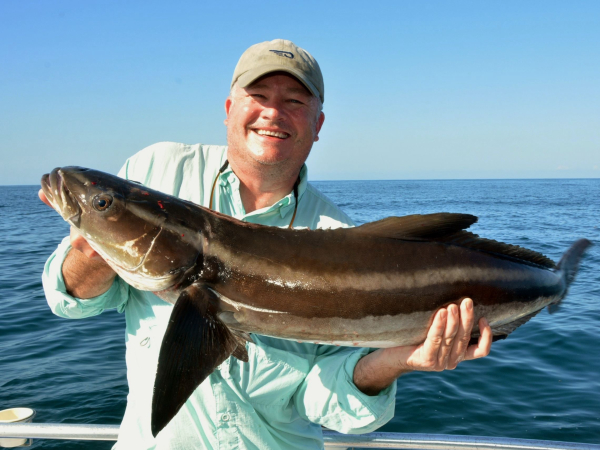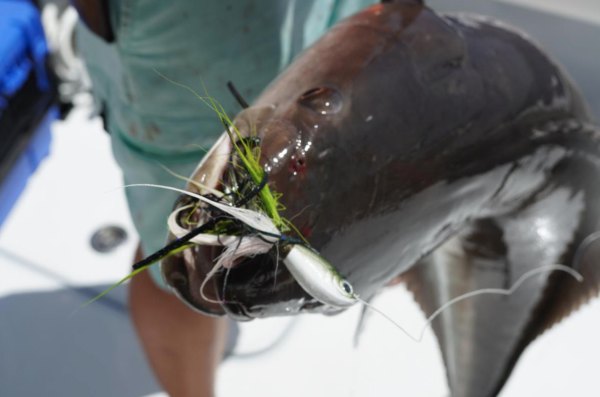
Cobia like this one are getting hard to find, even for Captain Troy Frady, an Alabama skipper who specializes in them. (Troy Frady)
By Frank Sargeant
frankmako1@gmail.com
When I first fished Panama City Beach about 1977, one of the most amazing sights was the cobia fleet which prowled just outside the “green bar”, the sandbar about 100 yards off the beach that more or less runs all the way from Panama City to Mobile Bay.
During the peak runs in spring, it was common for an endless line of boats, most with upper control stations or flying bridges (and a few even with foldout stepladders strapped down on the front deck—that was my boat), spaced out at several hundred yards apart, cruising that bar from about 9 in the morning until 3 or 4 in the afternoon.
The high sun hours and polarized glasses made it easy for the anglers to see what they were looking for, the brown-black torpedo shape of cobia or ling. It was common to see 50 or more fish in a day—fishing was incredible.
During the spring migration, pods of these fish—anywhere from a pair to a dozen—slid westward along that bar, heading who knows where but probably to where all cobia then went to spawn.
Most of them did not make it.
Cobia are known as “dumb” fish, that is they are generally easy to catch. Throw a plastic eel (or a live one) or a pinfish/shrimp/crab in front of them and it’s usually an instant hookup. Not only that, but like dolphin-fish, they follow their hooked schoolmates to the boat so that multiple catches are sometimes possible.
Not only were there dozens of charter and private anglers working on them daily, major cobia tournaments were instituted, drawing many more anglers to the runs.

Cobia also prowl the waters around Tampa and Sarasota bay, but numbers are down there, as well. (Captain Rick Grassett)
Cobia are aggregate spawners, biologists tell us—the school up to drop eggs and milt. But the spawners were not making it to their spawning spots. Day after day, year after year, the largest fish—many over 80 pounds—were caught and dragged to the docks.
Cobia is a tasty table fish, and all those fish did not go to waste. But neither did they get a chance to spawn.
Before long, anglers began to notice the big fish had all disappeared. Now a 40 pounder was a big one.
Not too long after that, most of the 40 pounders were gone, too. (The same thing has happened in Tampa Bay over the last 30 years—a once abundant fishery there is now mostly reduced to an occasional incidental catch.)
There’s not a lot of mystery to the demise of this fishery. It’s the same thing that has depleted a wide variety of coastal fish over the years—any fish that is too easy to catch gets caught, and eventually the cumulative impact of all of us—each taking only a little—destroys the fishery we love.
The “Tragedy of the Commons” applies in spades to fisheries
Some anglers have tried to blame the reduced stock on the 2010 Gulf oil spill, but that seems an unlikely culprit considering that all other fish stocks in that area of the Gulf are now doing fine. And everybody’s favorite bugaboo, global warming, is also unlikely, since the fish historically migrated along the shores in the cool weather of early spring. Another frequent cause of reduced fish stocks, commercial fishing, does not seem to apply to cobia because they can’t be caught in large numbers easily—the recreational take is many times the commercial take.

Any sort of jig or eel imitation can catch cobia, but they're easiest to catch on live bait. (SPRO)
Cobia live in two separate stocks per NOAA Fisheries, with an Atlantic Stock from Virginia through North and South Carolina and Georgia, and a Gulf Stock along Florida’s east coast and around the Gulf of Mexico to Texas.
The Atlantic Stock does not travel in quite such an easy route to predict, and so far fish numbers seem to be holding steady, with a total harvest annually of around 80,000 fish for the recreational anglers, per NOAA Fisheries.
In the Gulf, on the other hand, almost everybody who used to fish for cobia now says cobia fishing sucks.
Making the Needed Changes
In 2022, the Gulf Council reduced the annual catch limit for cobia of 4,500,000 pounds down to 2,600,000, almost cutting it in half. The Council also reduced the bag and vessel limit to one cobia per person, two per vessel. The next Gulf-wide stock assessment is scheduled for 2025.
The Council has also begun polling anglers on how the fishery has changed, and what might work to fix it.
Florida has recently increased the minimum size limit on Gulf and Atlantic cobia from 33 to 36 inches. The bag is now one per angler per day, but only two per vessel. Alabama went to a 36” size limit in 2019, Louisiana last year dropped the bag to one per angler, two per vessel and maintained a 36” limit and Texas also went to a one per day limit and 36” minimum. Only Mississippi maintains a 2 fish per person limit and no boat limit.
The waters west of Mobile Bay are not so prone to overfishing because the water is too murky for sight fishing in most areas, so the targeted swarming spring harvest does not occur.
Hopefully these measures will see a return to something like former abundance in a few years. Cobia are fast growing, with females maturing at around 36” in three years, so they can come back fast when the pressure is reduced. Anglers can do their part by backing the regulations and obeying them throughout the areas where we’d all like to see that great spring cobia run return.